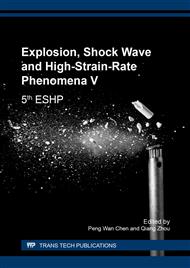[1]
B. Gulenc, Y. Kaya, A. Durgutlu, I.T. Gulenc, M. S. Yildirim, N. Kahraman, Production of wire reinforced composite materials through explosive welding, Arch Civ. Mech. Eng. 16 (1) (2016) 1-8.
DOI: 10.1016/j.acme.2015.09.006
Google Scholar
[2]
M.K. Surappa. Aluminium metal matrix composites: challenges and oppurtunities, Sadhana- Acad P Eng. 28 (1–2) (2003) 319–334.
DOI: 10.1007/bf02717141
Google Scholar
[3]
S. Saravanan, K. Raghukandan, 2014, Diffusion kinetics in explosive cladding of dissimilar alloys as described through Miedma model, Arch. Metall. Mater. 59 (4), 1615-1618.
DOI: 10.2478/amm-2014-0274
Google Scholar
[4]
C.M. Anand Partheeban, M. Rajendran, S. C. Vettivel, S. Suresh, N.S.V. Moorthi. Mechanical behavior and failure analysis using online acoustic emission on nano-graphite reinforced Al6061-10TiB2 hybrid composite using powder metallurgy, Mater. Sci. Engg. A 632 (2015).
DOI: 10.1016/j.msea.2015.02.064
Google Scholar
[5]
V. Umasankar, M. Anthony Xavior, S. Karthikeyan. Experimental evaluation of the influence of processing parameters on the mechanical properties of SiC particle reinforced AA 6061 aluminium alloy matrix composite by powder processing, J. Alloy Compd. 582 (5), (2014).
DOI: 10.1016/j.jallcom.2013.07.129
Google Scholar
[6]
T.W. Chou, A, Kelly, A, Okura. Fibre-reinforced metal-matrix composites, Compos, 16(3) (1985) 187-206.
DOI: 10.1016/0010-4361(85)90603-2
Google Scholar
[7]
P. Tamilchelvan, K. Raghukandan, S. Saravanan. Kinetic energy dissipation in Ti-SS explosive cladding with multi loading ratios, IJST, Transactions of Mechanical Engineering 38(M1) (2014) 91-96.
Google Scholar
[8]
K. Hokamoto, A. Chiba, M. Fujita, T. Izuma. Single shot explosive welding technique for the fabrication of multilayered metal base composites: effects of welding parameters leading to optimum bonding condition, Compos. Part B. Eng. 5 (8) (1995).
DOI: 10.1016/0961-9526(95)00059-v
Google Scholar
[9]
S. Saravanan, K, Raghukandan and K. Hokamoto, Improved microstructure and mechanical properties of dissimilar explosive cladding by means of interlayer technique, Arch. Civ. Mech. Eng. 16 (4) (2016) 563-568.
DOI: 10.1016/j.acme.2016.03.009
Google Scholar
[10]
A. Durgutlu, B. Gulenc, F. Findik, Examination of copper/stainless steel joints formed by explosive welding, Mater. Des. 26 (6) (2005) 497-507.
DOI: 10.1016/j.matdes.2004.07.021
Google Scholar
[11]
M. Acarer. Electrical, Corrosion and Mechanical properties of aluminium-copper joints produced by explosive welding, J. Mater. Engg. Perform. 21 (11) (2012) 2375-2379.
DOI: 10.1007/s11665-012-0203-6
Google Scholar
[12]
S. Saravanan, K. Raghukandan, Thermal Kinetics in explosive cladding of dissimilar metals, Sci. Tech. Weld. Joi. 17 (2) (2012) 99-103.
DOI: 10.1179/1362171811y.0000000080
Google Scholar
[13]
M. Honarpisheh, M. Asemabadi, M. Sedighi, Investigation on annealing treatment on the interfacial properties of explosive welded Al/Cu/Al multilayer, Mater. Des. 37, (2012) 122-127.
DOI: 10.1016/j.matdes.2011.12.045
Google Scholar


